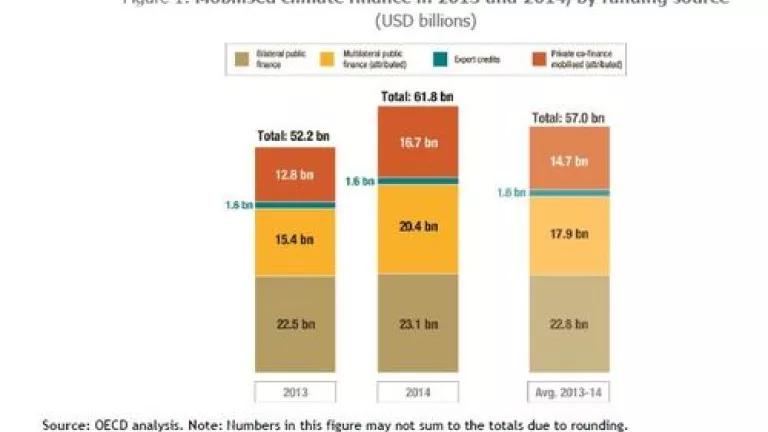
A new OECD/CPI report has estimated that public and private climate finance mobilized by developed countries for developing countries reached $62 billion in 2014 and $52 billion in 2013. This preliminary estimate provides clear evidence that climate finance is starting to be scaled-up to help mobilize public and private investments globally into low-carbon and climate resilient economies.
Here are the key findings and some implications.
More resources are being mobilized towards the $100 billion per year target in 2020
In Copenhagen, developed countries agreed to mobilize $100 billion per year by 2020 of climate finance to assist developing countries in reducing emissions and adapting to the impacts of climate change. At the climate negotiations in Lima countries were discussing having an interim target in 2016 of $60 billion. According to the OECD data countries are on the path towards the 2020 objective of mobilizing $100 billion (see figure).
More finance will clearly be needed, but this data highlights an emerging trend of increased resources.
Funding sources are varied, and support various climate finance needs
The increased funding in 2014 compared to 2013 came largely from increased financing by multilateral development banks. Multilateral finance reached $21 billion in 2014 and $15 billion in 2013. This does not even count funds for the new Green Climate Fund, which became operational only recently, and is expected to provide significant climate financing. And it appears that the private finance that has been mobilized could be larger as the report notes that this isn't yet a full picture. The chart below shows the proportional sources of finance.

We have seen an important recognition by the international development banks that they need to stop funding dirty energy and shifting more of their resources towards a low-carbon economy. And new commitments from several development banks provide some positive momentum in this regard. The Asian Development Bank has just announced that it will double annual climate financing to $6 billion by 2020, which will account for about 30 percent of its overall financing. The European Bank for Reconstruction and Development is shifting its priorities and increasing financing for sustainable energy and resource projects to 18 billion Euros over the next five years, in response to the G7 group's recent call for a transition to low carbon growth.
Of the total finance, 77 percent went to support emission reduction efforts, adaptation accounted for 16 percent, and 7 percent of financing targeted both objectives. An important note on the methodology is that finance for coal-related power generation is not counted, except in cases of carbon capture, storage or use. (Japan and Australia count the financing of high efficiency coal plants as climate finance - but fortunately, such finance was not counted for this report - since the support of new fossil fuel infrastructure is frankly antithetical to the notion of climate finance.)
A first look at private finance
This report is the first to provide a global estimate for mobilized private finance. The estimates are $16.7 billion for 2014 and $12.7 billion for 2013. The increasing scale of private climate finance shows that the world is moving one step closer to the scale of action needed to transition to a low-carbon future. In reality, the scale of private finance is only partially represented in this report, as countries and multilateral development banks have collected limited data on projects financed in the past. The methodology for collecting this information is still evolving. Estimates for private finance associated with public grants, loans, credit lines, direct equity, fund-level equity and guarantees are all partial. And, leverage ratios to estimate mobilized private finance are not used - meaning that in some cases mobilized finance for which the authors did not receive data were not counted.
Climate finance data becomes more transparent
The report draws on data from countries and international financial institutions, as well as preliminary data on private co-financing associated with public finance interventions, such as export credits for the renewable energy sector. Having estimates of mobilized private finance has been a huge undertaking, and the estimates are only a partial total of the amount of climate finance that has actually been mobilized. As the mobilization of private finance gains momentum, we'll expect to see improved methodologies and transparency from companies and governments on reporting the numbers.
Momentum for greater financing - still need to "shift the trillions"
Around the world, governments, institutions and companies are "shifting the trillions" in investments away from fossil fuel financing and towards low carbon growth.
Given the rise in climate finance and the improved transparency and ability to measure public and private finance, we are on a path to meeting the Copenhagen commitment for $100 billion in annual climate finance by 2020.
